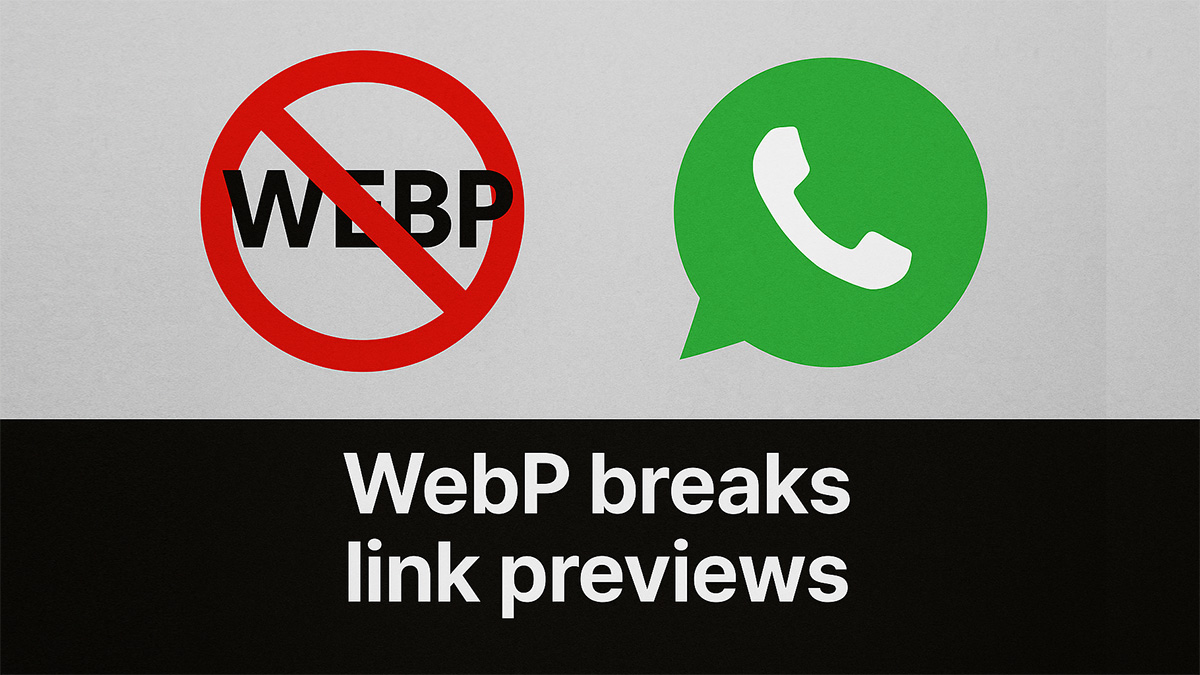The Threat of WebP for WhatsApp — The Untold Truth

Today, a client of ours who sells real estate in Tenerife reached out with a frustrating issue: when she shares property listings with her clients on WhatsApp, the link previews are broken. Sometimes there’s no image. Sometimes even the title and description disappear. Just a few days earlier, everything worked perfectly — a beautiful card with a photo and details would appear automatically.
WhatsApp and Link Previews: Why It Matters
WhatsApp isn’t just a messaging app. It’s a key communication tool for millions of businesses worldwide. In many industries — especially real estate, e-commerce, and services — sending links via WhatsApp is an essential part of the sales funnel. And when those links look broken or empty, it erodes trust instantly. People don’t click on links that appear incomplete or suspicious.
We started investigating. The website was properly configured: Open Graph tags like og:title, og:description, and og:image were all present and correct. The page structure was fine. Nothing had changed in the CMS or theme.
But there was one recent adjustment: a few days ago, the site had enabled automatic image conversion to WebP format using the EWWW Image Optimizer plugin. And that’s when WhatsApp previews began to fail.
WebP and Site Speed: A Double-Edged Sword
At first glance, WebP looks like a smart solution. It offers smaller file sizes and faster loading speeds. Google loves it. PageSpeed Insights gives your site better scores. It’s tempting to adopt it across the board.
But here’s the problem: WebP is not fully supported by all platforms — especially not by WhatsApp.
WebP was created by Google to replace older formats like JPEG and PNG. Most modern browsers support it. But when it comes to WhatsApp, things fall apart — particularly when WebP is used in the og:image tag, which powers the preview card when a link is shared.
Why WhatsApp Fails to Show WebP Images
WhatsApp’s preview system doesn’t reliably support WebP on either Android or iOS. If your page uses WebP as the primary image in the OG tag, WhatsApp often won’t display it. Instead, it might show just the text. Or nothing at all.
Here’s what typically happens:
Your optimization plugin (like EWWW, Imagify, or LiteSpeed) automatically generates WebP images.
Your server uses content negotiation to serve WebP to most user agents.
WhatsApp scrapes the link, receives a WebP image, and can’t render it.
The preview breaks — no image, no engagement.
And it gets worse. WhatsApp caches the preview on the first attempt. If it fails to load the image once, that blank state may be saved for days — even after you fix the issue on your site. Unlike Facebook, WhatsApp has no tool to manually refresh link previews.
Common Mistakes When Diagnosing the Problem
Website owners and developers often spend hours debugging the wrong things. They test OG tags. They change descriptions, update image sizes, add MIME types. They may even think the site is hacked or blacklisted.
But none of that will help if WhatsApp receives a WebP image that it can’t process.
The problem isn’t in your tags — it’s in the format.
How to Fix It (and Avoid It)
To prevent this issue and ensure your WhatsApp previews display correctly:
Use JPEG or PNG for
og:image, not WebP.Make sure the image URL ends with
.jpgor.png— no redirects or dynamic content negotiation.Configure your server or CDN to not serve WebP to social media crawlers.
Avoid plugins that automatically rewrite OG images to WebP.
Don’t rely on JavaScript or lazy-loading — WhatsApp only parses raw HTML.
Test your links in WhatsApp before major campaigns or content launches.
Also, watch out for CDN behavior. Services like Cloudflare or BunnyCDN may automatically convert images to WebP. Even if your OG tag points to a .jpg, the CDN might serve WebP instead. Always check your HTTP response headers — if you see content-type: image/webp, WhatsApp may break your preview.
WebP Is Great — But Not for Messaging Platforms
WebP is genuinely useful for optimizing internal performance. It’s fast, efficient, and ideal for browser rendering. But when your content relies on external sharing — especially through platforms like WhatsApp — it becomes a risky choice.
Until WhatsApp updates its rendering engine, the safest and most reliable solution is to use JPEG or PNG for all Open Graph images.
Final Thoughts from a WordPress Developer
I’ve been building WordPress websites for nearly a decade. Together with my team, we don’t just create sites — we help businesses grow through:
SEO optimization
Google Ads and Facebook Ads
YouTube channel setup
Google Maps presence
Speed optimization
One of the most critical areas we focus on is improving website speed, especially according to Google PageSpeed Insights. Why? Because a fast-loading site leads to more trust, more conversions, lower ad costs, and better rankings in Google.
But optimization is always about balance. Pushing too hard in one direction — like adopting WebP everywhere — can hurt your visibility and communication on platforms like WhatsApp.
It’s not just about loading speed. It’s about how your content appears when someone shares it. And that can be the difference between a click and a lost opportunity.
About the Author
This article was written by Gennadii Pratsevych, WordPress developer with nearly 10 years of experience in website optimization, SEO, and digital strategy.
If you have questions or need help with your WordPress website, feel free to contact me here or email me directly at info@speedwppro.com.
